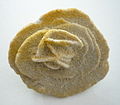Sand rose
A sand rose (also desert , barite or gypsum rose ) is an irregularly shaped crystal structure, which usually consists of grains of sand embedded in a crystal made of gypsum or barite .
The water-soluble gypsum roses arise in hot and dry desert areas , i.e. under an arid climate . Due to the rapidly evaporating surface moisture, groundwater is pumped upwards by capillary forces . The salts dissolved in the water crystallize out due to the progressive evaporation and together with the sand form the characteristic, leaf-shaped structures. These are mainly found in North Africa in the Sahara and in Namibia .
Barium roses, which are insoluble in water, are formed in a similar way in sand deposits if there is sufficient barium available , for example in the Wetterau , where they can be found in some sand pits ( Rockenberg ).
Many exceptional sand roses are extracted in the Tunisian salt desert Chott el Djerid at depths of up to 50 m. Specimens with a weight of up to 6 t are found.
Sand roses are durable when stored appropriately and are also popular collector's items.
In the "Sandrose Museum" in the Untertor in Büdingen exhibits are exhibited. Most of them come from the Wetterau.
Web links
- Mineral Atlas: Sand Rose and Barite Rose (Wiki)




